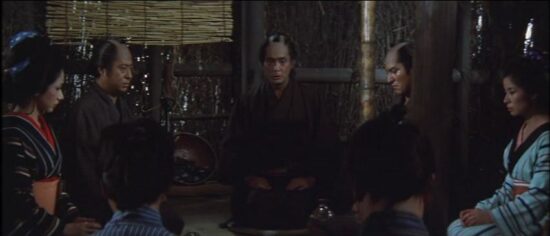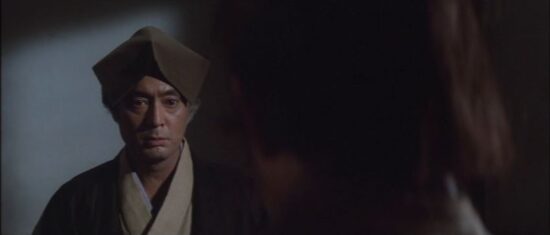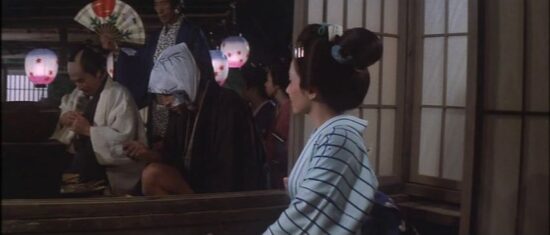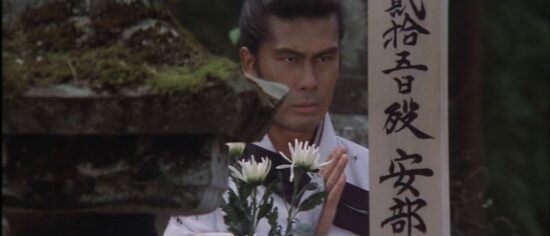
The recent discovery of Bandits vs. Samurai Squadron (Kumokiri Nizaemon, 1978), a film that I had never seen before, has added a new work to my stock of movies for my research on Japanese film in general and on Gosha’s oeuvre in particular. Not as well known as Goyokin (1969) or Hitokiri (1969), Bandits vs. Samurai Squadron, the adaptation of Shotaro Ikenami’s novel with the same Japanese title, is perhaps not Gosha’s finest movie, but as with his other films that I have seen over the years, I enjoyed the richness of the narrative and the film’s aesthetic appeal.
The first sequence of this period film set in the early 18th century establishes its narrative basis – the struggle between robbers and the police, and in particular between the gang of the infamous Nizaemon Kumokiri (Tatsuya Nakadai), and the police force for arson and theft, a special unit consisting of samurai and led by Shikubu Abe (Koshiro Matsumoto). The focus is on the planning and execution of criminal operations and on the hunt for the robbers, thus creating many opportunities for cleverly arranged sword-fighting scenes and suspense.
Bandits vs. Samurai Squadron – a heist film disguised as a jidai geki (period film)? Straddling genre boundaries, period film here meets film noir, borrowing some of its themes, aesthetics and atmosphere. However, far from being merely imitation, it develops its own original dynamics, switching between spectacular action and long sequences of more ordinary activity shown in great detail.
The film’s Japanese title, Kumokiri Nizaemon, is the name of one of its characters. Nizaemon Kumokiri (according to the Western order of given name followed by family name) is the boss of a successful gang that stole 100,000 ryo (the gold currency used before the Meiji Restoration in the second half of the 19th century) over a period of ten years. However, the narrative does not focus on a central figure. Instead, it combines several strands that are sometimes only loosely connected before culminating in a big showdown in which the last remaining secrets are revealed.
Some of the characters figure more prominently – for example, the samurai Shikubu and the robber and prostitute Ochiyo (Shima Iwashita), one of the strong women in the film, who is in love with her boss Nizaemon. Most of the characters remain rather flat but have a clear dramatic function, enriching the narrative by providing it with unexpected turns, as in the case of one of the members of the police unit. The sudden appearance of this man interrupts a swordfight between Shikubu and Nizaemon, which in a more conventional film would have been the climax as they are the two main antagonists. This former samurai is seeking revenge on Shikubu, who deprived him of his samurai status for treachery, and his intervention allows – even if involuntarily – the gangster boss to escape.

Bandits vs. Samurai Squadron depicts the underworld of the Edo Period (1600-1868) – a violent, unstable and largely nocturnal world in which all paths lead to death and where the sole motivation seems to be purely material. As in Akira Kurosawa’s Yojimbo (Yojinbo, 1962), set a hundred years after the action in Gosha’s film, money is at the core of a society in which merchants, the lowest of the four classes in a system ruled by the samurai, have become increasingly influential. However, social criticism is less overtly expressed in Bandits vs. Samurai Squadron than in Goyokin or Hitokiri, and Matsuya, the rich merchant played by Tetsuro Tamba is something of a caricature and also a likeable character who, blinded by love, has married Ochiyo. Her sole aim was to find out where his money is hidden, and Matsuya bursts out laughing when he discovers his shop and warehouse in ruins following the robbery.
There are other, hidden motives behind the crimes, most of which have to do with the figure of Nizaemon, whose true identity is not revealed until the third part of the film. In its references to Nizaemon’s past, the film connects its heist film elements more closely with jidai geki conventions, making it clear that social injustice is the motivation behind his criminal career. Nizaemon is Iori Tsuji, the brother of the samurai Kuranosuke Tsuji (Hakuo Matsumoto), who was wrongly accused of embezzlement. Having refused to kill himself, Kuranosuke lives the life of an outcast and is in this respect rather like Nizaemon.
As collective punishment for his supposed crime, the members of Kuranosuke’s family are put to death, and ten years after this terrible event, Kuranosuke pleads with his younger brother Iori to avenge these deaths. He is disappointed by Nizaemon’s refusal, and later gives himself up to the police, pretending that he himself is the famous gang boss. He is executed as Nizaemon, whereas the real Nizaemon takes on his elder brother’s identity in order to take revenge on the samurai of his former clan, who had ruined both his (Nizaemon’s) and Kuranosuke’s lives.
Several minor characters also commit acts of revenge – former samurai and now ronin (masterless samurai) living in the social margins like Nizaemon, who, unlike his brother, chose the life of an outcast. Revenge is an important motif in Japanese culture, including jidai geki and chambara (swordfighting films). It is certainly not a coincidence that the first name of the older Tsuji brother is Kuranosuke – Oishi Kuranosuke is the leader of the 47 ronin in one of the most popular revenge stories in Japanese history, literature and film.
Criticism of the samurai and their code of honour, unmasked as mere façade, and of a profoundly corrupt and unjust society have been central topics in many jidai geki since the 1920s, including Gosha’s own films (Goyokin). In the sombre, nocturnal scenes of Bandits vs. Samurai Squadron, the boundaries between good and bad are blurred, robbers and the police are reduced to mere silhouettes – dark figures that look very much alike. The highly stylized violence sequences, distancing the viewer, produce a strong feeling of instability that is heightened by the pervading darkness. Shots of crowded interiors and obstructed views generate moments of oppression.

The narrative, fragmented by flashbacks, and the fast editing in the combat scenes (which creates fragmentation on a visual level) contribute to the atmosphere of insecurity and fear and a latent violence which is perhaps even more disturbing than the film’s brutal combat scenes with numerous shots of blood gushing from wounds. The sound of the heavy rain in the great swordfighting scene at the end and Mitsuaki Kanno’s haunting music score – the variations on the main theme, sometimes lively, sometimes melancholy, the dissonant electronic sounds and the unnerving monotony of a plucked instrument – heighten the film’s menacing atmosphere.
Gosha describes a violent underworld whose protagonists on both sides are professionals behaving in a way that makes them plausible for the contemporary viewer. Shikubu tries to understand his opponent’s motivation and, respecting him as a human being, sees Nizaemon as a man of honour. Nizaemon himself is presented as an old fashioned godfather figure who deserves this respect. Despite all its nihilism and the tragic futility of Nizaemon’s revenge, during which his former fiancée is killed, and with the reasons for his act of revenge presumably buried forever, Bandits vs. Samurai Squadron ends with a glimmer of hope. Shikubu, who has resigned his position with the police, fulfils the promise he gave to Kuranosuke/Nizaemon and tends his grave. In Masaki Kobayashi’s Harakiri (Seppuku, 1962), the name of the rebellious ronin will not appear in the clan’s chronicles. Erased from history, it is as if he – the individual – has never existed. Bandits vs. Samurai Squadron ends on a rather more positive note, with Nizaemon’s name removed from the criminal records (and therefore cleared) and with his memory kept alive by Shikubu.

